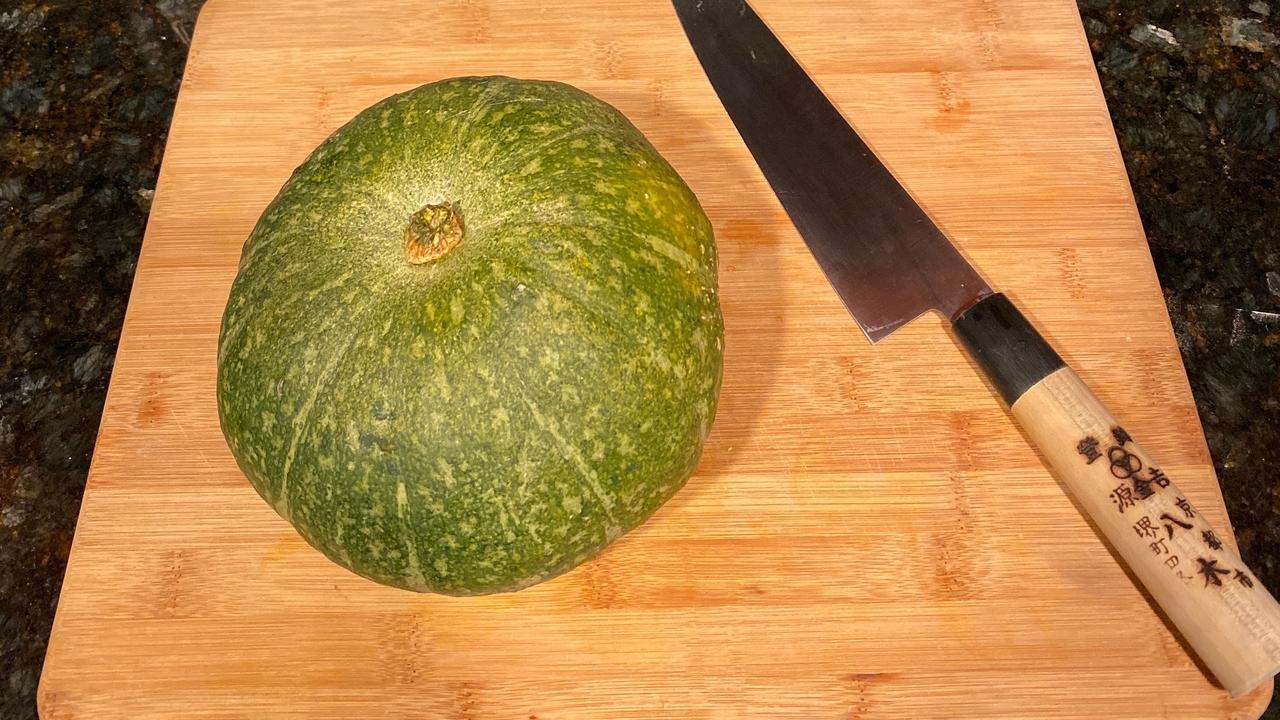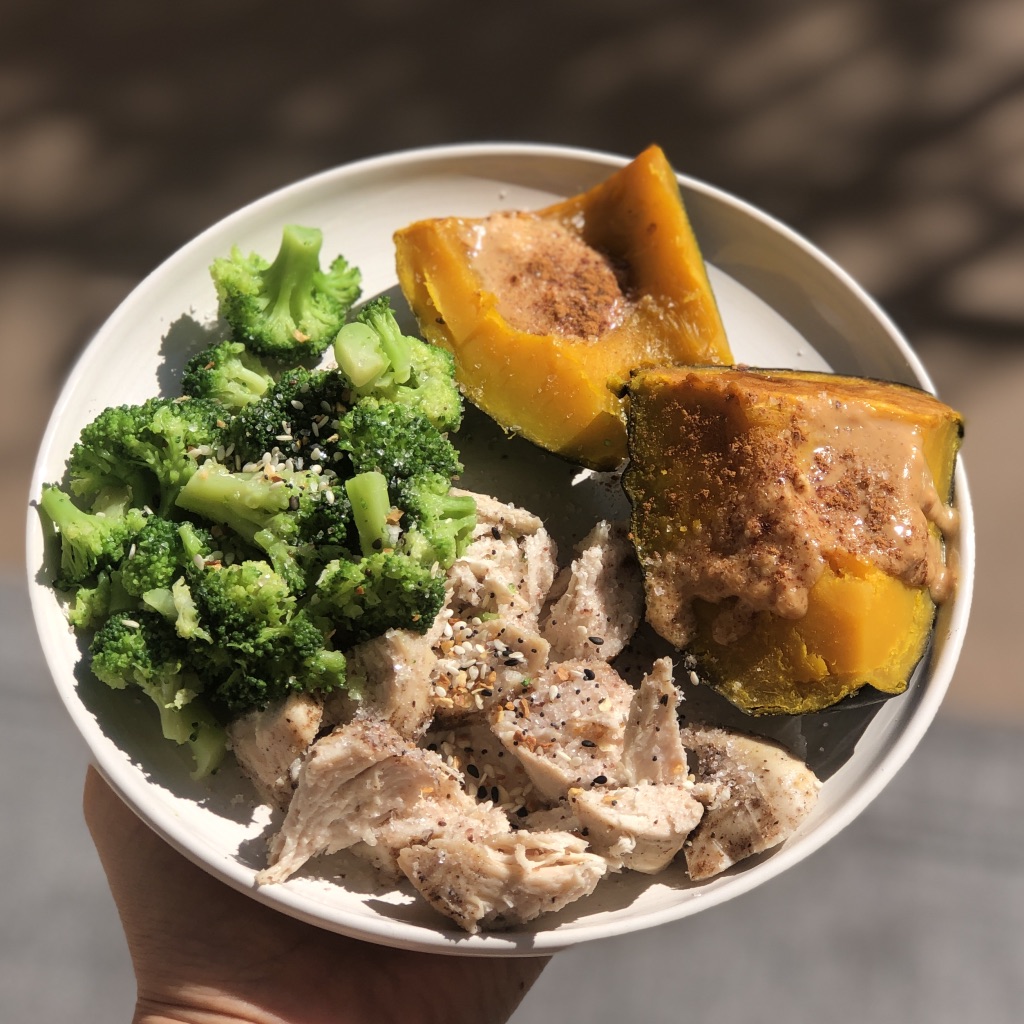
Nature's Candy - Kabocha Squash
Nov 16, 2019If you’ve been following me on Instagram or Facebook lately, you’ve likely seen that I’ve developed a new love (some may call it an obsession 🤪) with a particular variety of squash.
Over the past few months, I’ve started incorporating a bit more carbs into my daily regimen (read this post if you’re confused about why I’m incorporating more carbs..but wait till after you finish reading this one 😆 ). These carbs have been coming mainly from sweet potatoes, different varieties of squash, and fruit.
I was browsing through the squash section of the grocery store one day and came across this green pumpkin-looking thing (which I later discovered, thanks to Mr. Google, that it was called kabocha squash or ‘Japanese pumpkin’) and I decided to give it a try.
I roasted it in the oven with some salt and when I tasted it, I was blown away. Seriously, it was THAT good. It tasted like a cross between a pumpkin and sweet potato with a sweeter, slightly nuttier flavor.
So, I decided to do a bit more digging on this new-found love and discovered some pretty cool facts about it.
Kabocha Squash Nutrition
Kabocha Squash is a Japanese variety of winter squash that’s rich in nutrients like beta carotene, iron, vitamins A & C, potassium, magnesium, calcium, iron, manganese, and five B-complex vitamins, including B1, B3, B6, pantothenic acid, and folate.
Not only is it packed with nutrients, but kabocha is actually lower in carbs compared to other winter squash varieties which makes it a perfect keto-friendly or lower carb option.
For example, a 1/2 cup (~123 grams) of cooked kabocha has only 6 grams of carbs compared to the same amount of butternut squash which has about 13 grams of carbs.
Kabocha has even been named a ‘superfood’ in certain cultures due to its high levels of carotenoids, antioxidants, and phytonutrients.
Why I Love Kabocha
In addition to the variety of nutrients that kabocha has to offer, there are a few other reasons why I’m personally in LOVE with this delicious superfood:
-
The flavor is out of this world
-
If you prepare it properly (see below), it has a very nutty, sweet, distinct flavor that I’ve never experienced from any other squash.
-
-
Great replacement for sweet potatoes
-
If you love sweet potatoes (like I do), kabocha is a perfect alternative due to its sweet taste and even lower carb count (if that's what you're looking for)
-
-
Extremely versatile
-
Kabocha can be prepared in a variety of different ways depending on what you’re in the mood for (see my two favorites below).
-
-
No peeling or waste
-
The skin of the kabocha is 100% edible. Once cooked, the skin becomes super tender and it’s also packed with fiber and nutrients.
-
How to Pick the RIGHT Kabocha Squash
Kabocha is grown year-round, but they are best in the late summer to fall months. Just like an avocado or a banana, you want to make sure you're not getting a kabocha squash that is underripe. If you do, it will NOT taste like what I described above. Instead, it will taste bitter and not sweet at all.
Here's what to look for:
- COLOR: You want to look for a squash that is deep in green color. It's okay if it has some orange or lighter patches, bumps, or blemishes, but just make sure it is mostly green.
- WEIGHT: You want a squash that actually feels heavier for its size. Pick up the squash and use your judgment here. The heavier it is, the better!
- FEEL: The squash should be firm to the touch.
- SIZE: The size doesn't really matter, as long as you check the boxes with color and weight, you'll be good to go!
When you cut it open, the perfect squash will be dry, flaky, and have a deep orange color. The underripe, bitter squash will be watery and pale.
Trust me, you'll know the difference once you cook and taste a ripe vs. underripe kabocha. I've gotten some underripe ones before and although they're still edible, they just don't do the ripe kabocha justice.

How to Prepare Kabocha
Here’s my go-to method for preparing kabocha (step-by-step pictures are below the steps):
- Preheat your oven to 400 degrees Fahrenheit.
- Rinse your kabocha under cold water and grab a sharp, heavy knife and cutting board.
- The skin is a bit tough to cut through when it’s raw so be very careful. One trick to make cutting easier is to microwave the kabocha for 2-3 minutes (depending on the size). This will soften the skin a bit and make it easier to cut through.
- Cut the kabocha right down the middle (make sure you put your weight into it and keep your fingers clear, we don’t want any emergency room visits).
- Once it’s cut in half, scoop out the seeds and stringy stuff (you can discard the seeds or save them to roast just like pumpkin seeds).
- At this point, you can either put the knife down and cook the kabocha as is (my preferred method because it's just way quicker haha)...or you can continue cutting it into smaller triangular pieces (see pictures below).
- Once cut, lightly brush melted coconut oil or olive oil on the orange flesh and then sprinkle with salt and other desired seasonings
- For sweet, dessert-style kabocha, I like to use cinnamon or pumpkin pie spice.
- For savory, side-dish kabocha, I use different spices such as ground garlic, onion, curry powder, or different varieties of my favorite Caribeque Seasonings or Redmond spices. You can use any spices you like, switch it up and experiment with what you love best.
- Now we’re ready to roast! On a silicone or parchment-lined baking sheet, place the kabocha flesh-side down (if you only cut in half) or flesh-side up (if you cut into smaller pieces).
- Place in the oven and cook for 30 to 45 minutes or until the kabocha is soft and the skin is very easily pierced with a fork (might be longer depending on the size).
- Pro tip: I've found that sometimes the longer you cook it, the more caramelized it gets. But other times, the longer it's cooked, the more it falls apart and becomes a bit too mushy. It will take a few times to get the perfect texture for what you like.
- Remove from the oven, let cool, and keep reading for how I personally love to eat my kabocha 😍




Option 1 (preferred):

Option 2:




How I Eat Kabocha
Kabocha with Nut Butter, Cinnamon, and Salt



Kabocha Breakfast and/or Dessert Bowl
-
Recipe HERE


Ready to join a group of strong, confident, badass women?
Don't miss a beat!
Get my weekly tips, exercises, recipes, and more fun stuff to your inbox every Friday.
Your information is safe.


